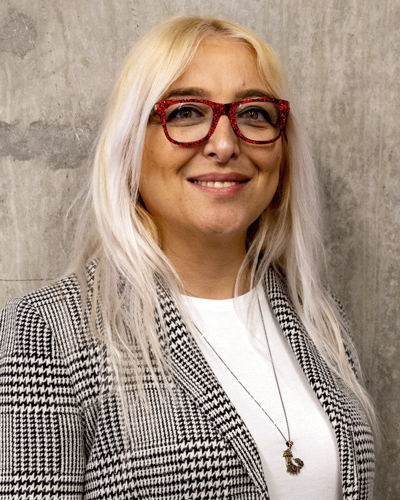Dissertation Award 2024-25

Onstead Institute announces Asli Kinsizer as the 2024 Dissertation Award Recipient
Spring 2024: The Onstead Institute Dissertation Award recipient is Asli Kinsizer, a CVAD art education doctoral student and teaching fellow in the Department of Art Education at the UNT College of Visual Arts and Design. The Onstead Institute Dissertation Award of $5,000 recognizes doctoral candidates in art education whose scholarship exhibits excellence within the field.
 "We congratulate Asli and are proud to offer this opportunity to our excellent CVAD
art educators," said Heidi Strobel, CVAD associate dean for academic affairs.
"We congratulate Asli and are proud to offer this opportunity to our excellent CVAD
art educators," said Heidi Strobel, CVAD associate dean for academic affairs.
Students are eligible if they have completed all coursework for the Ph.D., except for their dissertation hours. The award celebrates art educators at a vital point in their careers while contributing to the Onstead Institute's mission of developing, supporting, and sustaining innovative art and design practices and processes for K-12 education through a program of research, project administration, and public dissemination of information.
A committee of CVAD's four visiting professors, Letitia Huckaby, Beth Link, Donnie Nie, Layla Seale, and CVAD Leadership Team members Peter Hyland, Manisha Sharma, chair of the Department of Art Education, and Heidi Strobel, made the selection. The committee evaluated each applicant's originality of ideas presented, the strength of the submitted written and creative work, potential impact on the field, and the project's feasibility within the given period.
Kinsizer is a postcolonial feminist artist, educator, and researcher pursuing her doctoral degree in the CVAD at UNT. Aside from her master's degrees in Art Education, Turkiye, 2006, and in digital media and graphic design from the State University of New York, Oswego, 2019, Kinsizer has more than 20 years of teaching experience at both the K-12 and college levels in Turkiye and the United States.
“When teaching my students art history, visual culture, and digital media classes, I always aim to be a humanitarian art teacher. I encourage them to use their critical lenses without judgment and analyze the big picture," says Kinsizer. "My artistic activities include an ongoing exhibition titled Strong Women, community-engaged art projects, a CVAD gallery internship, and workshops focused on promoting cultural diversity and bringing society together in a bias-free environment to build bridges between communities and underrepresented groups.”
"Deconstructing an Orientalist Fantasy of Harem, Hammam, and Odalisque Through a Feminist Intersectional Postcolonial Lens" examines the continuing influence of colonial thinking on the teaching and reading of canonical art images. The specific case of Turkish women and Turkish culture is examined from the standpoint of canonical images in Western art and counterpoints from contemporary Turkish female artists," says Kinsizer.
"To present a multilayered and nuanced research study, I intend to use participatory action research methods to collect data and feminist textual analysis to interpret it. I construct my research with an interdisciplinary approach that has the potential to impact (1) the critical teaching of art historical material in art education courses through a global/ multicultural and feminist/ womanist lens; (2) exemplify the incorporation and use of technological tools in such teaching; and (3) the thin body of literature in art education on the complexity of Turkish culture and identity as a way to think about teaching national cultures (and their art) in nuanced ways rather than homogenizing it."
In addition, this research aims to provide art educators with a strategy for creating
a third space through the World Café Methodology, which emerges from the non-traditional
classroom. Through intersecting discussions among future artists, K-12 educators,
and non-art students as global citizens, the discourse of authenticating non-Western
styles of analyzing Orientalist artworks is taken beyond its confines. I have been
cultivating broader connections to ensure students see themselves in the various artworks
and histories for their future roles as art teachers or global citizens. I have been
also investing significant time in researching postcolonial educational practices,
new developments in non-traditional art education, and artists from underrepresented
groups.